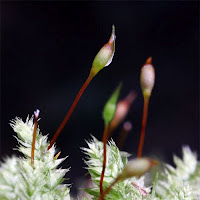Trawling the scientific news and literature can be an obsession - there's just so much incredible stuff being discovered all the time. It's also hard to choose favorite items, whatever ability to prioritize that evolution has endowed humans with, it's not always very effective. So, with that by way of an excuse, there were two utterly unrelated items that popped up last week that I cannot choose between - your vote.
The first involves something I'd never thought of before. Terrestrial moss (yes moss), produces spores to propagate, since it is a flowerless and seedless plant. Spores are tiny capsules a few tens of micrometers across and are perfect for being dispersed in the air. The puzzle has been that when the wind blows on Earth there is usually a small layer of atmosphere, about 10 cm wide, that serves as an interface between the planet surface and the free-flowing air. If you want to be carried off by the wind you need to get above this layer that's a result of friction, fluid dynamics, and topography. Most mosses lurk no more than about a centimeter above the ground - so how do they get their spores into the mossy equivalent of the jet-stream?
A paper by Whitaker & Edwards in Science examines the problem, and with ultra-high speed photography they find that some mosses use pressurized, explosive, capsules of spores to launch them upwards with g-forces of as much as 30,000. Although this is impressive, as lilliputians it results in a roughly 30 mile-an-hour Vespa-like launch velocity. The puzzle is that even this shouldn't get the spores high enough. The new study provides the answer - the exploding capsules are such that they produce a spore-laden vortex ring that burrows its way up to the magical 10 cm altitude. It's very much like a smoke ring, a complex structure that maintains integrity. In effect, natural selection has endowed moss with both a knowledge of the bigger picture of terrestrial atmospheric science, and some fluid mechanics that Boeing would envy. It's a further reminder that even 'simple' life is seldom just that.
One then wonders if a planet like Mars once had spore launching organisms littering its surface. A new paper by Morris et al. fills in one of the blanks. With all the geological evidence that Mars was, at least for a time, a wet place there has remained a bit of a conundrum. The simplest way for Mars to have been more temperate was for it to harbor a thicker, carbon-dioxide rich, atmosphere - with a strong greenhouse effect. If that had ever happened then there should be massive amounts of carbonate rich rocks laying around from that era. Until now the evidence for this had been scant. By studying the walls of Gusev crater with the Spirit rover Morris et al. get a look at the geological history - and they have now identified significant, and ancient, carbonate deposits from about 3.5 billion years ago. Checkmark the box.
It's not the end of the story, but it adds significantly to the evidence for a warm, wet, young Mars. The next question is how long did it retain this climate - long enough for life?
Subscribe to:
Post Comments (Atom)









No comments:
Post a Comment